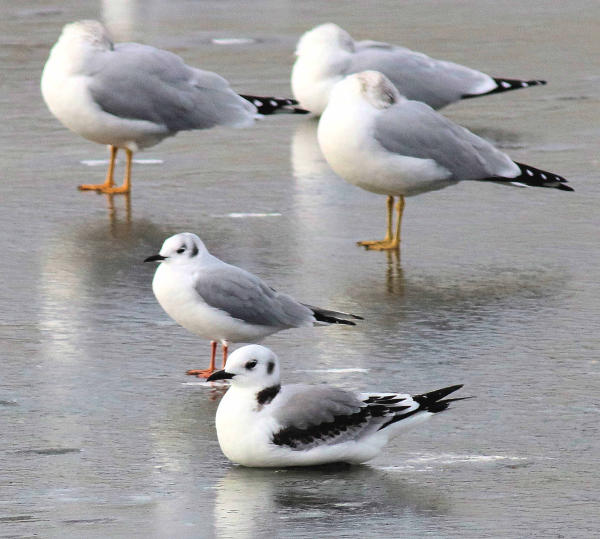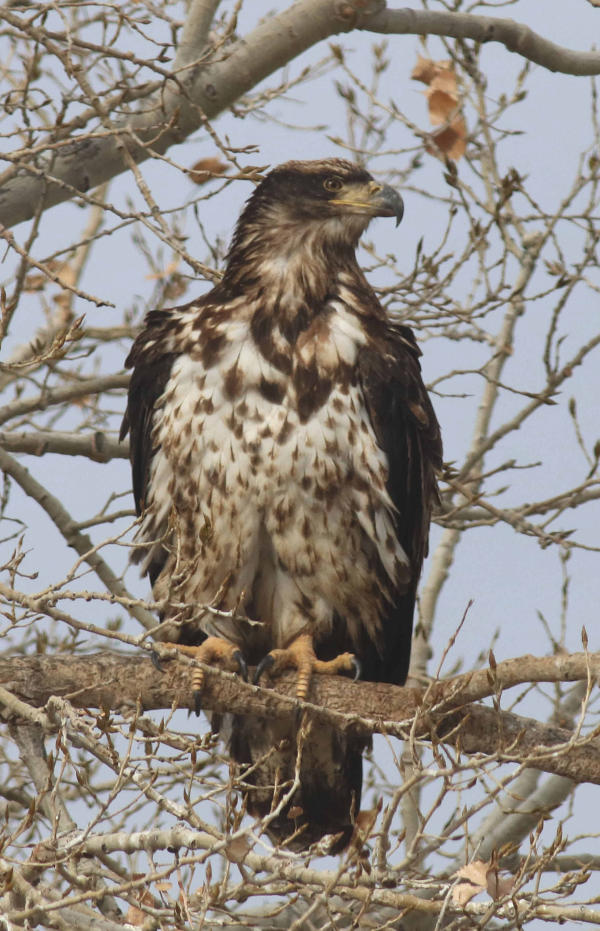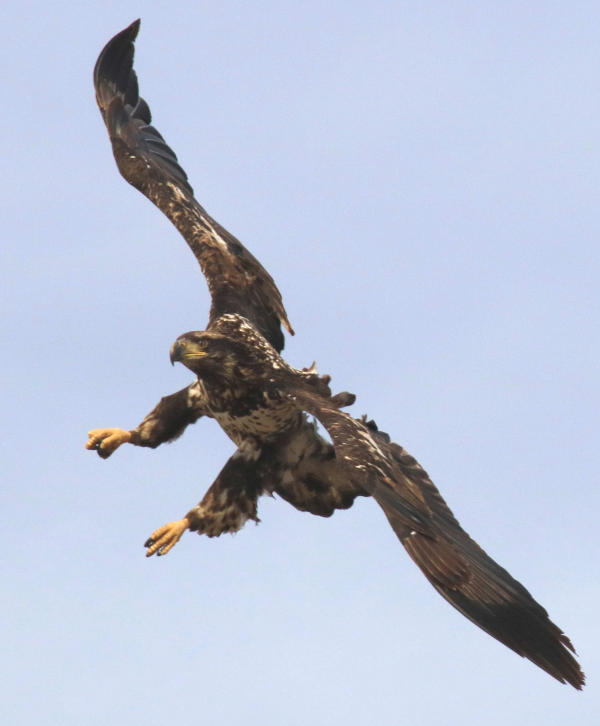
An immature winter Black-legged Kittiwake with a Bonaparte’s Gull and three Ring-billed Gulls in the background.

A second-year “white-belly” Bald Eagle perched (above) and banking in flight (below).

|
A recent neighborhood highlight was an adult female Merlin that surprised me as it flew up from the road just 200 yards south of home. It was apparently seeking water in a meltwater puddle during a warm afternoon. I was able to follow the bird as it moved from perch to perch, and returned to another meltwater pool to drink. New Year’s Day yielded only a few birds, but in true winter form, they were exciting birds!
First, two male Ring-necked Pheasants, but the third, fourth and fifth birds of the year were adult Snowy Owls, each separated by several miles. Number six was a fly-over Short-eared Owl, but smaller birds were represented too by a flock of about 50 Snow Buntings completing my sunny winter field trip. This surge of Arctic birds was probably the result of a blizzard with 40 mile per hour north winds that dissipated the night before. During subsequent local birding drives, I found another Snowy Wednesday afternoon, and two more late Friday – all immatures.
Backyard
My feeder birds remained pretty static over the holidays, but I’m happy to report the addition of a Red-breasted Nuthatch to the usual Blue Jays, Downy Woodpeckers, House Finches, White-breasted Nuthatches and a female Hairy Woodpecker. I also had a quick look at an unusual pale White-breasted Nuthatch that lacked any black coloration, and the usual blue-gray plumage was a pale light-gray. I was able to get a quick initial look at this unique bird, but I haven’t seen it since – darn.
I had a chance to check out some feeders at a rural nature center in southern Minnesota during a break in our family Christmas festivities. The feeder birds clearly showed the difference between the avifauna of the Great Plains and Eastern Woodlands with the addition of some telltale species – namely Red-bellied Woodpeckers and Northern Cardinals, plus wintering Purple Finches and Dark-eyed Juncos.
The most common birds were Black-capped Chickadees, which brought up a point that has baffled me for some years – the loss of Black-capped Chickadees in my home bird community. I can only imagine that perhaps West Nile virus affected the once-common chickadee population, which has yet to repopulate the area. But I’m not seeing any migrant or wintering chickadees either.
SoDak Birds
I also took another trip south to photograph birds of prey, which was exciting and fruitful the first day, but the second day I was disappointed by the weatherman in that the prescribed mostly sunny day turned out to be cloudy. But that made me opt to check a couple locations I don’t normally visit, which eventually proved to be a good move. First, I searched a Missouri River location for Black Scoters that were tallied during the Pierre Christmas Bird Count. No luck for me, which is usual for my rare bird chases; but I continued to the tailrace at Oahe Dam, which was attracting some rare gulls.
My primary interest was an Iceland Gulls which would be a new species for me, but the only big gulls present were Herring Gulls, joined by Ring-billed Gulls and Bonaparte’s Gulls – a favorite species. Then I noticed a “different” gull loafing on a frozen pond on the edge of a mix-species flock. The black line of feathers along the wing was tell-tale, and I identified it as an immature Black-legged Kittiwake, a small gull species normally limited to the northern Pacific and Bering Sea.
I have seen thousands of kittiwakes on nesting islands and offshore Bering Sea locations in both Russian Siberia and Alaska. Nonetheless, this was the first immature kittiwake I’ve seen, and the first winter-plumage Black-legged Kittiwake – and I was able to photograph it!
The real photo opportunity below the Oahe Dam was a young “white-belly” second-year Bald Eagle. This bird permitted me and a few other drivers to pass under its position, which was actually just above the access road to the tailrace. I photographed the trusting eagle perched, and later noticed that it took flight and surveyed the area along the dam where water was discharged. A bit later, as I watched the tailrace for passing gulls and mergansers, I saw the young eagle flying in my direction.
I reacted by training my camera on the eagle as it steadily glided toward me – and its original perch. The big female’s wingspan soon spread across my photo frame, then it banked steeply to the side with its legs hanging low to increase the effect of gravity and to stabilize it, then leveled off to land on the same branch as it was perched on when I arrived. Way cool action for taking a dramatic series of photos!
Hope you had a beautiful holiday season with plenty of birding excitement mixed in; and I wish for you to keep growing in your enjoyment and understanding of birds and birding throughout the new year!
Article and photos by Paul Konrad
You can share your sightings and photos at editorstbw2@gmail.com